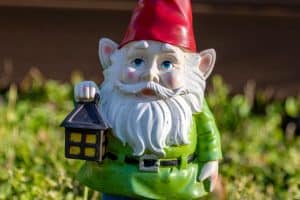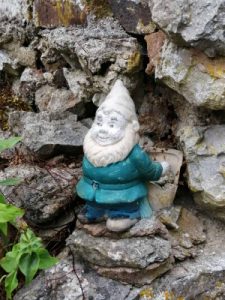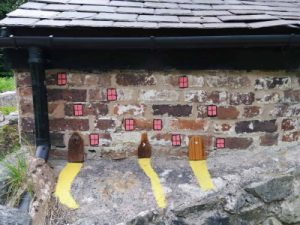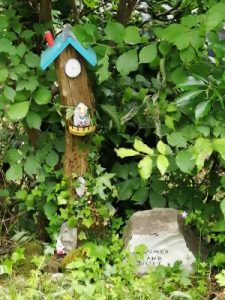
Garden Gnome Frequently Asked Questions
(NB Links may be affiliate links. See my disclosure here)
During my many trips to the internet to find out more garden gnomes to bring to my website, I often come across people searching for gnome questions and answers and fun facts about gnomes.
So, to help those looking for garden gnome information, I have compiled a list of questions I have seen and my attempt to answer each one.
Here are my answers to some common questions about gnomes. My answers contain some fascinating garden gnome facts and legends and may or may not be accurate or correct!
They are genuine Garden Gnome FAQs but my answers are all a bit of fun.
What are garden gnomes known for?
Garden gnomes are known for bringing a little bit of joy to your garden.
Though they are not the only type of garden statuary, they are the most well-known.
Many garden gnomes were created as statues to scare off animals looking to get into your garden and steal your plants or other items. Another reason that gnomes have become so popular is because of their “cute factor.”
Many people like to display them to make their gardens look more exciting and inviting.
What do gnomes eat?
I wonder if anyone knows what gnomes eat, as they never spend leisure time with humans. Like most mythical creatures, gnomes stay mysterious about it and say nothing.
But there are some fun theories about what gnomes eat that you might want to try out for yourself. The best thing about these recipes is that they’re so simple to make—you can whip up a big batch of gnome food in no time.
Gnome Bread: This recipe is super easy and uncomplicated and can be made with items you probably have around the house. All you need are two packages of French bread, butter or margarine, garlic salt, a container of green olives, and cheese (we used shredded cheddar). Cut the bread into cubes and mix it with the butter and garlic salt until combined. Top with cheese and olives. Bake at 350 degrees for fifteen minutes or until golden brown.
Gnome Stew: This recipe uses ground beef, potatoes, carrots, onions, salt & pepper, Worcestershire sauce, and tomato sauce to create a hearty stew.
What powers do gnomes have?
Do gnomes have any powers? In many ways, yes.
The gods have granted them magical abilities to help protect nature and all living things on earth. Gnomes can move things with just a touch of their finger. They can also use their powers to heal wounds if they want to be helpful to others.
However, these are only some of their powers. Gnomes also possess other powers that most people don’t know about. What are those? Are there any limits to what they can do? We just don’t know.
They can live in your garden without you ever seeing them move. They’ll watch over it, protect it, and give you the benefits of their labor.
All you have to do is feed them (see above).
Gnomes have gardening powers and can do most of the work in a garden because they’re very handy with tools. Plus, they’re really good at digging holes.
I hope you are enjoying these Garden Gnome FAQs. Let’s carry on.
Are Gnomes evil?
We all know that gnomes are friendly little fellows with pointy red hats. Some people also believe they do bad things, like stealing garden gnomes and digging in the neighbor’s yard at night.
However, we can’t be sure that they are naughty little goblins. Is there any way to find out if gnomes are evil?
People have reported strange encounters with these creatures for hundreds of years. Sometimes, people say they’ve seen garden gnomes moving during their sleep or disappearing altogether.
Although these stories could have been made up, it’s not impossible to believe them—if somebody really wants to steal your garden gnome, he probably can.
These reports might also suggest that the creatures are naughty because they cause trouble for humans in general.
*** WATCH THIS VIDEO TO SEE GNOMES WHO ARE EVIL ***
What is a group of gnomes called?
What is the right way to refer to a group of gnomes?
You might have heard it’s a “gaggle” of gnomes, but this is only true if you’re referring specifically to a group of plump garden-dwelling lawn ornaments.
Gaggles are generally defined as a group of geese, which happens to be where “gaggle” comes from. So while it may sound cute, technically, it’s incorrect.
A more appropriate term for a collection of garden gnomes would be a “team” or a “troop.” These terms are especially apt considering how gnomes live together in your garden, getting along and getting all the work done for you.
On Wikipedia, they suggest it is a Donsy, but I don’t know why.
What are tomte gnomes?
Tomte gnomes are living creatures that live in houses and protect property from bad luck. It’s a bit like a house elf, but for real.
In English, they’re sometimes called “nisse,” or “nisse figures” or “nisser.”
The tomte is the most Scandinavian of all the gnome species.
The tomte is a small, mythical creature who protects the home and farms from intruders. They look like ordinary gnomes—bearded with pointy red hats (except for one species that wears a green hat)—but they have special powers. For example, they can grant you good luck in love or grant your wish for more prosperity on your farm.
What are the Christmas gnomes called?
Christmas Gnomes are ceramic figurines that can be placed outside to act as decorations for the holiday season.
They are usually shaped like a little fat person with a pointy hat, covered in clumps of clay, and painted with bright colors.
The figurines are usually dressed in a red suit, but some might have a green or green-and-red suit instead. Some of these figurines come with a white beard, which is attached to their chin by a string and has a little bell at the end.
They are often placed on top of small wooden fences or walls, standing in the middle of a round lawn ornament, or even being displayed next to trees.
In recent years, indoor Christmas gnomes, known generally as tomte, have become very popular. They are like the ceramic Christmas gnomes described above but are made of fabric, so they can be purchased as indoor ornaments and decorations.
See my collection of the Best Christmas Gnomes here.
Do gnomes celebrate Christmas?
Of course, they do! The many reports of gnome sightings on Christmas Eve and Christmas Day are proof of this. Gnomes are friendly, and they love to make merry with the other creatures of the forest. They enjoy singing carols, engaging in snowball fights, and decorating the forest with festive holiday lights.
The biggest celebration of the year is Santa’s annual visit to each gnome’s home. As his sleigh passes over their gardens, he stops to bestow presents on all good gnomes. Some say that if you leave out a plate of cookies and milk for Santa on Christmas Eve, he might even stop by your house (though whether he will actually eat your cookies is anyone’s guess).
Garden Gnome FAQs continue here.
What are gnomes with no eyes?
Past years have seen a surge in popularity for garden gnomes, but it’s weird to see so many of them without eyes.
I am still trying to figure out the answer to that question.
How does this happen? Are they born with no eyes? Does it happen organically? Would gnomes be offended if you asked about this?
But I have noticed that the tomte or nisse gnomes often have their hats pulled down so that it looks as if they have no eyes.
What is a lady gnome called?
I’m sorry, but there is no clever answer to this.
A female garden gnome is called a “lady gnome,” just like a lady human is called a “lady human.”
She is called Betty or Erica or Clara or whatever.
Why do people put out gnomes?

I have three theories about this.
Theory 1: They’re a sort of good luck charm.
Theory 2: The practice has something to do with German folklore. A popular fairytale in Germany is that gnomes live underground, where they guard treasures such as gold and jewels.
Theory 3: It’s simply for fun! No matter what you believe, putting out a garden gnome or other ornament seems like a fun thing to do.
Perhaps there’s no reason behind it—it just seems like something that would be cute to have in your garden.
Do gnomes like humans?
I’ve been reading a lot about gnomes lately and have been considering whether or not they like us. After all, we’re always building new buildings and roads, which upsets their home environment. And how we cut down trees and destroy forests has to be hard on them.
But Gnomes have been around since ancient times, so they must have always survived somehow. But they may have been able to preserve their habitat by retreating deep into the ground and staying there for some time. They don’t mind when people build things over their homes or chop down trees where they live. And since they’re so small, they can live in places that are too small for us humans to like living in.
Gnomes are also magical beings, so it may not hurt them when we build upon their lands because magic protects them from the influences of modern life and allows them to thrive no matter how much construction goes on around them.
So, I assume that gnomes do like humans or, at the very least, are willing to put up with us.
Is a gnome good or evil?
Gnomes are the iconic garden-variety garden and lawn ornaments of popular imagination. They’re the innocuous little men and women who are always involved in some kind of activity—planting flowers, playing with children, or generally just hanging out.
Gnomes are seen in our culture as entirely harmless. But there’s a reason for that: we’ve all been conditioned by the culture to see them as innocent and harmless characters, if sometimes a bit mischievoius.
But could it be that these seemingly harmless little garden statues have more sinister intentions? Could there be a dark side to those seemingly harmless little garden statues?
Gnomes are like people in that they possess a wide range of personalities and characteristics. Some gnomes may be highly empathic and caring, whilst others are malevolently bad and evil.
In folklore, though, they tend to mostly be neutral, staying away from humans and not doing anything to harm or help them physically.
But they are considered magnets for luck which is why many people keep them in their gardens and homes.
Do Gnomes protect your home?

You may wonder if your garden gnomes are protecting your home when you are out and as you sleep.
The nice answer everybody wants to hear: Yes.
Gnomes are considered lucky and will protect your home at all times.
The harsh answer, which may be more truthful, : No.
Giving your home protection through an army of garden gnomes is, in fact, nothing more than a myth. Just like Santa, who secretly only delivers toys to the good boys and girls of the world, the old belief about gnomes was that they protected only those who deserved it. But unlike Santa, gnomes don’t actually have any power over whether or not someone deserves good fortune.
What do Gnomes do at night?
After a hard day of tending to their garden and keeping an eye on your house, what do gnomes do at night?
They get ready for bed, of course! As everyone knows, when its bedtime for a gnome, it’s time to go to sleep.
And just like humans, gnomes want to sleep in the most comfortable way possible. But if you’ve ever tried sleeping on top of a big pile of dirt, you know that it can get pretty uncomfortable.
That’s why every night before they go to bed, gnomes will shake out their bedding—which is actually your lawn—and make sure that they’re nice and comfy for the night.
Some people claim that the best way to stop a gnome from stealing your flowers or vegetables is to set up a nice lawn for them to lie on.
What is the origin of garden gnomes?
Gnomes have been around since the late 1800s, and have gained popularity in recent years.
Garden gnomes are a mix of two distinct groups.
The first is the traditional “jardinière,” which are hand-carved statues meant to guard the small gardens of French nobility.
The second group was the “nemuri-ningyo” statues, which were sold as souvenirs to Japanese tourists who visited France in the late 1800s.
Japanese artisans came up with the idea of putting European clothing and beards on these statues, and they were shipped back home as gifts for families and friends.
In 1903, an American named Joshua Crowther introduced these sculptures to America to decorate his business, Crowther’s Garden Gnome Emporium. He gave a new name to this statue: “garden gnome.” Although garden gnomes have been popularized by Crowther’s marketing efforts, the origins of these statues actually come from France!
You can read more in-depth on my Gnome page here
Are there gnomes in my house?
You never know; there might be. Consider my experience.
I thought I was losing my mind. I would go to bed at night, fall asleep, and wake up at odd hours during the night, thinking I heard little “gnome noises” coming from inside my house.
It was driving me nuts, so I searched online to see if anyone else had this experience, and apparently there’s a phenomenon called “house gnomes”.
It’s when you hear noises in your home but can’t figure out what it is.
The weird thing is people who have experienced it say that they hear these sounds in the wee hours of the morning or right before a big storm is about to hit. There are things like tiny footfalls, doors opening and closing, weird creaking, etc
So, there might be. But there probably isn’t.
Why do gnomes wear red hats?
Why are gnomes nearly always wearing red hats? It’s a mystery that has plagued humanity for hundreds of years. Are they hiding from something? Did they run out of other colors of felt to knit with? Why don’t we see gnomes without hats?
But not all mysteries are meant to be solved, and we should be thankful that the folks who create gnomes have decided not to answer this pressing question. If they did, it might ruin all the fun of building a fantasy world around these tiny, jolly creatures.
Gnomes have many fascinating characteristics, like their love of beer and their tendency to live inside trees.
They’re a great source of entertainment for kids but also a bit mysterious for them. Kids grow up imagining what gnomes would do if they lived in their backyard or why those red hats stay perched on their heads when no one’s looking.
It’s an easy thing to talk about with adults, too: you can ask an older friend about how they heard of gnomes in the first place, or you can just laugh about how silly it is that someone would make an entire race of little people wear such oddly-shaped headwear.
What nationality are gnomes?
Gnomes are often depicted as little bearded people in red clothing, but the truth is that they are not people at all. In fact, they are dwarves, two different species of supernatural beings.
The similarity between the two has been noted throughout modern times, in stories, and even in cartoon characters such as Disney’s Snow White and Frozen’s Olaf.
Both species have a Scandinavian origin—dwarves from Norse mythology and gnomes from German folklore.
Are garden gnomes offensive?
Okay, so garden gnomes are supposedly charming and friendly people, but anyone who has ever owned one of these tiny folk knows that many of them are in fact, the exact opposite of what they seem.
Sometimes they are obnoxious, ugly little guys who just take your lawn and property for granted. I’ve been looking for evidence to prove my theory that garden gnomes are offensive and rude.
After a bit of research, I’ve found some proof that many of these little imps do indeed have bad habits. In most cases, their crimes are minor, but it’s still pretty offensive behavior.
Are garden gnomes offensive? Many are, yes!
Look at these rude garden gnomes and check out how they cause offense.
Are gnomes still popular in 2024?

It’s is a good question: are gnomes still popular in 2022?
It’s been nearly thirteen years since the last “Gnome Census” was conducted, which is far too long to go without gathering valuable data about the state of the cute little garden creatures.
Though the last census was in 2010, things haven’t changed much in the intervening time. Gnomes are still very much in vogue.
Finally, The Truth about Gnomes
Gnomes are universally loved. They’re cute and funny and make good companions for children and adults.
I’m sorry to tell you this, but, there’s one thing that gnomes aren’t: real.
They’re fantasy creatures created in stories to be adorable sidekicks to garden-variety fairies. But here in our world, they don’t exist.
That’s right—gnomes aren’t real.
But if you’re still convinced that they are, you’re not alone! The myth of the garden gnome has been around for a long time. Ever since the 18th century, they were first invented in stories as part of a fairy tale.
Horticulture enthusiasts later adopted gnomes in their gardens because it was believed to bring good luck and ward off evil spirits. If you’ve ever seen pictures of old European gardens with statues or sculptures of little people, chances are they were actually depictions of gnomes!
Today though, these imaginary little guys are everywhere—from lawn ornaments to salt shakers to key chains—and are adored by many people worldwide.
We love ’em
Garden Gnome FAQs
I hope you enjoyed my Garden Gnome FAQs. I certainly enjoyed writing them. Please consider leaving a comment. It would be brilliant to hear from you.
